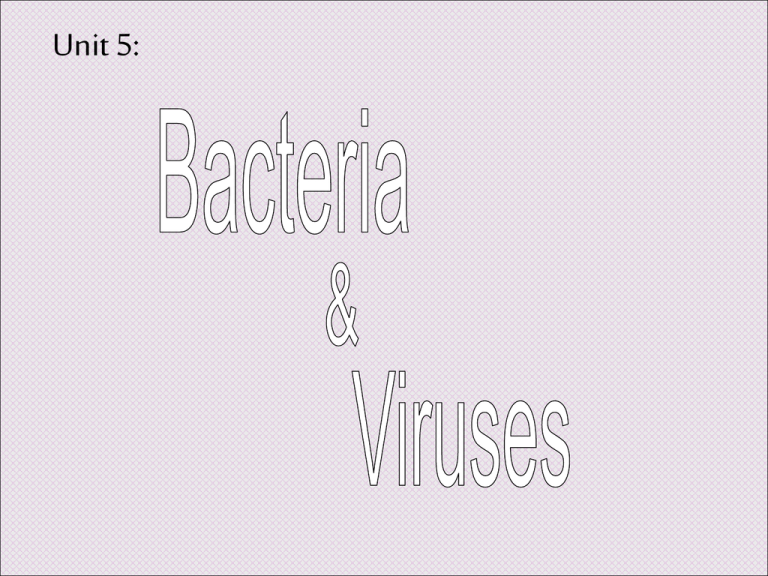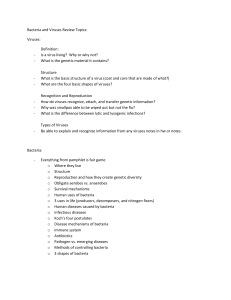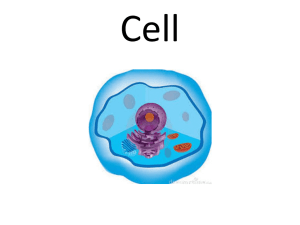Bacteria and Viruses
advertisement

Unit 5: Objectives: 1. Know the characteristics of bacteria. 2. Know what bacteria need for survival. 3. Know the difference between asexual and sexual reproduction. 4. Know how bacteria reproduce. 5. Know how bacteria can be helpful and harmful. 6. Know how viruses reproduce. 7. Know how bacteria and viruses are different. Kingdom Monera (Bacteria) Main Characteristics: • Made up of only one cell (unicellular) •Contain a cell wall •Do NOT contain a nucleus (Prokaryotic) • Most can not move from place to place • To obtain energy they feed off of dead organisms (decomposers) • Reproduce asexually (no sperm and egg) Survival In order to survive, bacteria need: • Water • Proper temperature • Most need oxygen (aerobic) • Energy (decomposers) Shapes of Bacteria Cocci: sphere shaped Bacilli: rod-shaped Spirilla: spirals Reproduction Asexual: • No exchange of genetic material • No sperm and no egg • Offspring are identical to parent Sexual: • Exchange of genetic material • Sperm and egg • Offspring are different from parent Reproduction in Bacteria Asexual reproduction occurs by binary fission. Binary Fission: one organism divides into two identical organisms. Bacteria reproduce about every 20 minutes. 40 min 0 min 20 min Proper temperature and moisture are required. Endospores, a thick protective covering, surround bacteria if proper conditions are not available. Harmful Bacteria • Spoil food • Cause diseases in plants and animals Helpful Bacteria • Help make foods; cheese, yogurt, butter • Help breakdown dead material • Some help fight other bacteria • Make chemicals or drugs to help people (example: insulin) • Found inside small intestine of humans to help digest food. • Some make nitrogen compounds for plants. Viruses A microscopic particle that invades a cell and often destroys it. Characteristics: • Smaller than bacteria • Can NOT “live” on its own. A host cell is required for reproduction. • Genetic material is enclosed in a protein coat. • Do NOT carry out all of the processes of living things. Viruses are NOT living organisms! Shapes of Viruses - crystals - spheres - cylinders - space crafts Reproduction Asexual reproduction occurs in viruses through the lytic cycle. • Many viruses are made inside a host cell. • The cell bursts to release the viruses. • Each newly made virus then attacks a different cell and repeats reproduction. Lytic Cycle 1. The virus finds a host cell. 2. The virus enters the cell or injects genetic material into the cell. 4. The new viruses break out of the host cell and find new host cells. 3. The virus’s genes turn the cell into a virus factory. Objectives: • Know the difference between non-infectious and infectious diseases. • Know what causes infectious diseases. • Know how infectious diseases are spread. • Know how to protect yourself against disease. • Know how your immune system fights diseases. Disease Something that causes your normal body functions to become disrupted. Two types of disease: • Non-infectious • Infectious Non-infectious Disease • No presence of a “living” organism inside the body. • Can NOT be spread from one living organism to another. • Examples: cancer, asthma Infectious Disease • Presence of a “living” organism inside the body. • Can be spread from one living organism to another. • Examples: Malaria, cold Infectious diseases are caused by pathogens. You call them germs! Pathogens An organism that causes disease. Kinds of Pathogens: • Bacteria • Viruses *(not living) • Fungi • Protists How Pathogens are Spread 1. Through the air. Example: sneezing, talking 2. Touching contaminated objects. Ex. door knobs, books, towels, drinking glasses 3. Person to person Ex. kissing, shaking hands 4. Infected animals Ex. being bitten or scratched by a sick animal 5. Soil, food and water Ex. eating undercooked food, unwashed fruit or veggies, drinking dirty water How to Protect Yourself Against Disease. 1. Wash your hands frequently. 2. Cover your mouth when you sneeze and cough. 3. Stay away from animals that are acting strange or are unknown to you. 4. Wash your fruits and vegetables. 5. Wash areas where raw meat has been. 6. Do NOT eat raw or undercooked meat or eggs! How to Prevent Disease Pasteurization: Developed by Louis Pasteur in 1800’s. Heating liquids to kill bacteria in wine, milk and cider. Vaccine: An injection that contains a weak or dead pathogen. Your body recognizes and fights the pathogen but you do not get symptoms. Immunity: Resistance to a disease. Fighting a Disease Antibiotics: A medicine that will kill or slow the growth of bacteria and fungi. Antibiotics do NOT work on viruses! Immune System: Macrophage: Engulf or eat pathogens inside body. T cells: Kill infected cells and activate B cells. B cells: Make antibodies, proteins, for each specific pathogen allowing them to be destroyed. Remember pathogens to fight infection faster if you come in contact with the same pathogen again.








